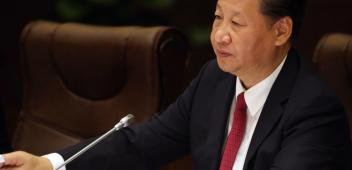The predicament of proximity: how should Australia respond to China's rise to power?
The predicament of proximity: how should Australia respond to China's rise to power?
Michael Fullilove
The Saturday Paper
22 March 2014

Executive Summary
For most of our history, the world was run by distant countries much like our own. When the world map was painted pink, we were a part of the British Empire. Throughout the Pax Americana, Australia has been a treaty ally of the United States.
The order that has prevailed since World War II has served our interests. Western countries ran the international economy. American predominance was embedded in international institutions and reinforced by the US military.
But now two things are happening. Our great and powerful friends are becoming, in relative terms, less great and powerful. And wealth and power are moving eastwards, towards us.
China’s economy should be the world’s biggest within the next decade. Other rising Asian economies are also powering world growth. The Asian Development Bank predicts Asia will nearly double its share of global gross domestic product by 2050, thereby regaining the dominant economic position it held some 300 years ago, before the industrial revolution.
If the economic outlook in Asia is positive, however, the security outlook is unpredictable. Economic growth is magnifying interstate competition. A number of regional powers, including Japan, South Korea, India, Indonesia and Vietnam, are jostling for advantage. There are worrying tensions on the Korean peninsula and in the East and South China seas.
And the contours of the relationship between the US and China are unclear.
The US is the world’s leading power – the only country capable of projecting military power anywhere on earth. Our alliance with Washington is overwhelmingly in our national interest. Any argument that we should downgrade the alliance in order to please China is wrongheaded. Unsolicited gifts to rising powers are not reciprocated, they are pocketed.
It is true, though, that the challenge posed by China is unlike anything the US has faced before. And there are worrying signs about Americans’ readiness for the contest. Bloodied by its adventures in Iraq and Afghanistan, and hungry for nation-building at home, the US is turning inward. Barack Obama has little taste for forceful action, as we have seen in the cases of Syria and Crimea, and neither do most Americans.
President Obama’s most important foreign policy initiative is the pivot to Asia, which he outlined in Canberra in 2011. The pivot makes powerful strategic sense, but I’m concerned that America’s heart isn’t in it.
The military elements of the pivot – including a small presence of US Marines in northern Australia – are hardly overwhelming, even if they all proceed.
Politically, the pivot has gone off the boil. Last year, John Kerry made only four brief trips to Asia and 13 trips to the Middle East. Does that sound like a secretary of state who has pivoted to Asia? President Obama, too, has been distracted by troubles abroad and political dysfunction at home. It’s important that his trip to the region next month is not cancelled like the previous one.
The economic element of the rebalance is also in trouble. Even if Asian states agree on the Trans-Pacific Partnership (TPP), the US congress may not. Asia will be watching carefully to see how hard the president fights for TPP – because if it fails, it will prove that when it comes to the pivot, America has run out of puff.
Meanwhile, China has plenty of puff. In the past three decades, China has remade its economy and lifted hundreds of millions of people out of poverty. Increasingly, its economic success is mirrored in its growing military strength.
The US National Intelligence Council argues that the Indo-Pacific will be the dominant international waterway of the 21st century, as the Mediterranean was in the ancient world and the Atlantic was in the 20th century. And China intends to win the naval competition in the Indo-Pacific. The lap of Java undertaken by three Chinese warships last month was an indication of future intentions.
China’s façade conceals frailties, of course. Still, even if we don’t credit straight-line projections, it’s clear that China has arrived as a global player.
There is an uneven quality to China’s international stance: usually quiet but occasionally strident; usually cautious but occasionally combative; always prickly; never predictable. Sometimes Beijing’s assertiveness spills over into bluster, as with its recent unilateral declaration of an air defence identification zone over disputed territory in the East China Sea.
I hope the US recovers its confidence and reaffirms its Pacific presence. I hope China’s foreign-policy behaviour becomes more measured and predictable. But what if these developments do not occur? What if the two countries face off in a new cold war? Even more alarming, what if America retreats while China advances? What if Australia confronts the worst possible combination: a feckless America and a reckless China?
I hope we avoid this outcome. But nation-states must follow Disraeli’s lead, hoping for the best but preparing for the worst. Crimea shows that we can quickly find ourselves in worst-case scenarios.
For many years, Australians complained about the tyranny of distance. Now the tyranny of distance has been replaced by the predicament of proximity. Our new economic opportunities come with new political risks. We are closer to the world’s booming markets – and closer to the world’s developing crises. We are less isolated, and less insulated.
The answer to this predicament is to become more engaged with the world, not less. Australia needs a broader foreign-policy debate, a more capable military, and a foreign policy that combines ambition and coherence. We also need a more extensive diplomatic network.
Over the past two decades, the Department of Foreign Affairs has been run down and hollowed out. In the late 1980s, the Australian foreign service fielded more than 900 highly trained diplomats overseas. Today, the number is one-third less. Our network of 95 diplomatic posts looks puny compared with the OECD average of about 133. We have fewer posts than Norway, Sweden and Belgium, even though these countries are smaller and located more securely than we are.
Now, more than ever, we need a first-rate foreign service that can engage in energetic and creative diplomacy.
After all, compared with all other alternatives, talk is cheap.



